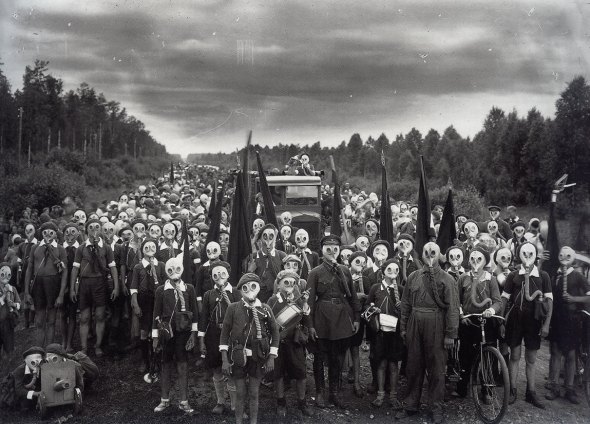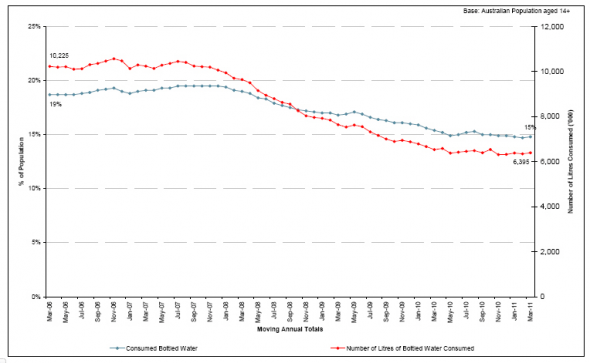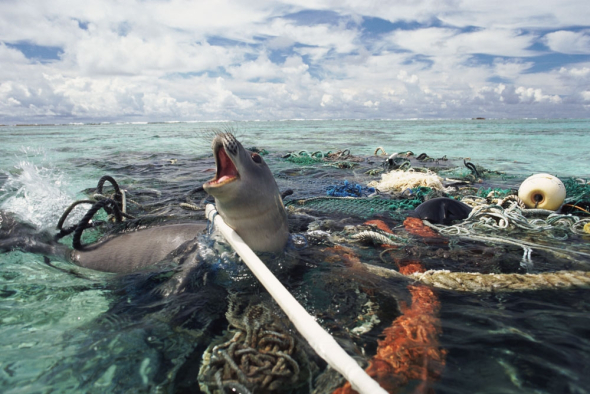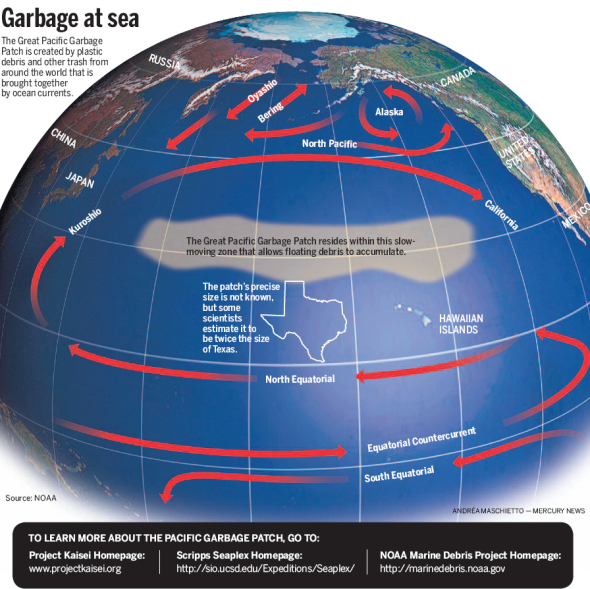Environmentalism - Chapter 14 Plastic pollution

Environmental pollution will be the future war to come - Who’s the enemy? Ourselves!.
Plastic is taking its toll on our wildlife which is killing many species of marine life and harming smaller new born aquatic species crating a life of misery and pain which effects not just costal animals but land and avian to.
Pollution is not just responsible for flora and fauna death, please don’t just take me on that word, YOUR the one that’s (going to responsible) for the birth mutations, breathing defects, cancerous cells to form, to land invasion of our own waste. It’s OK though as most of you will just flick through this and not give a damn. The quote I am rapidly become pissed of with (we only live once) is starting to grind on me, WE MAY but what about our generation of children’s children and theirs to come?.
The average family of four mother and father and two children will consume in one week bathroom/toiletry/cleaning containers/packaging, non-essential food containers (e.g. takeout food containers), drink bottles/milk jugs, essential food containers/packaging and other miscellaneous plastic trash (e.g. candy wrappers, snack bars) and this is still in a recent survey form 2012 that sees no reduction in the amount. People this is serious and needs addressing urgently. These items do not include “outside the family too” of which in the commercial working world one is using by far more from water bottles, to food packaging or plastic carrier bags.
The worst offenders are the family and the hypermarkets which still are not being eco-friendly to our environment in cutting the usage of bags or at least offering some form of “bag drop of point” that the member of the public can walk freely in to the hypermarket and purchase or freely obtain a carrier bag thus reducing “production + carbon emissions + usage = (recyclability)
On average the American “individual” not (family) uses between 300 and 700 plastic bags per year we have picked America as they are in the top three polluting nations of the planet with China coming first and India third, and regrettably the (family) will use to the nearest figure based on governmental and consumer data twenty thousand carrier bags per year per that’s a lot and still much of this is not being reused, recycled or placed in the “recycling bin” that ends up in waste dumps or within the oceans.
Shoppers worldwide are using approximately 500 billion single-use plastic bags per year. This translates to about a million bags every minute across the globe used. (Think that’s shocking?).
- If you joined them end on end they would circumnavigate the globe 4,200 times.
- 100,000 marine creatures a year die from plastic entanglement and these are the ones found.
- Approximately 1 million sea birds also die from plastic.
- A plastic bag can kill numerous animals because they take so long to disintegrate. An animal that dies from the bag will decompose and the bag will be released, another animal could harmlessly fall victim and once again eat the same bag.
- The floods in Bangladesh in 1988 & 1998 were made more severe because plastic bags clogged drains. The government has now banned plastic bags.
- In Ireland they introduced a 15c plastic bag tax and reduced their usage by 90% in one year. It is now 22 cents. (Yet this method is not really being put to practice across the globe)
- There are believed to be 46,000 pieces of plastic in every square mile of ocean.
- There are 5 ocean gyres in the world where plastic gathers due to current circulation. These gyres contain millions of pieces of plastic and our wildlife feed in these grounds.
- Every year, 6.4 million tonnes are dumped into the ocean. This is the same as 3,200 kilometres of trucks each loaded with garbage.
- At least two thirds of the world’s fish stocks are suffering from plastic ingestion. (You still eating fish?)
The upsetting fact is this more than a billion people around the world do not have access to safe drinking water. Most countries that buy bottled water have the luxury of quality tap water, yet despite this YET! And here is the point that I really would like you all “pay attention to”.
Americans consume 8.6 billion gallons of bottled watered a year. Yet there are very few water holes in third world nations of which they are families “dying for water” and children “dying from lack of (clean) water” you have the choice to reuse your water bottle and obtain the water from a tap yet you simply throw it away as (it’s dirty?) or you listen to the likes of Alex Jones (non-educated) and other non-qualified environmentalists and geologists quoting water is unsafe as it contains (fluoride) – You seriously are kidding yes?
The Bottle TRUTH;
- FACT – every year Americans use 91,733,000,000 (BOTTLE’S of water a year)
- FACT – every year the entire globe use 563,829,000,000 (BOTTLES of water a year)
- FACT – for every 12 ounces of water bottled 36 ounces are consumed
- FACT – 40% of bottled water comes from the tap and 0% has to adhered to governmental standards
- FACT – every year 17 million barrels of water are used to produce bottled water, that’s 340 million gallons of gasoline
- FACT – only 1-5 bottles are recycled
- FACT – the other 4 contribute to the three billion pounds of plastic water bottles added to land fills
The plastic TRUTH;
- 12 million barrels of oil are used to make the plastic bags consumed in the U.S. annually.
- Plastic creates 4 times the solid waste vs. paper bags; enough to fill the Empire State Building 2 1/2 times a year.
- 88.5 billion Plastic bags were consumed in the U.S. last year.
- It takes up to 1000 years for plastic bags to biodegrade in our landfills.
- The average family of four uses 1460 plastic bags a year.
- An estimated 500 billion plastic bags are sold worldwide each year.
- Less than 1% of all plastic bags are recycled in the U.S.
- Over 100,000 birds and marine life die each year due to an encounter with plastic debris, much of it plastic bags.
- Plastic is getting into the food chain. Even the finest particles of plastic represent a threat to creatures at the lowest level of the food chain in the marine environment, the filter feeders. Then, toxins in filter feeders are passed up the food chain to fish and other marine animals, which humans then consume.
- Plastic is over-running our planet. Estimates run as high as one million pieces of plastic per square kilometre (0.6 mile) floating in specific areas of the Pacific Ocean.
- When one ton of plastic bags are reused or recycled, the energy saved is equal to 11 barrels of oil.
Paper Bag Facts
- 14 million trees are cut down to make the paper bags used in a year.
- Only 20% of paper bags get recycled.
- When one ton of paper bags is reused or recycled, three cubic meters of landfill space is saved and 13-17 trees are spared! In 1997, 955,000 tons of paper bags were used in the United States.
- Paper cannot be recycled indefinitely. It can only be recycled 4-6 times. Some virgin pulp must be introduced into the process to maintain the strength and quality of the fibre, so no matter how much we recycle we will never eradicate the need for virgin fibre.
- Paper is the number one material that we throw away. For every 100 pounds of trash we throw away, 35 pounds is paper. Newspapers take up about 14 per cent of landfill space, and paper in packaging accounts for another 15 to 20 per cent.
The graph below explains the number of liters of bottled water consumed to the number to “consumed bottled water” up to 2011 and this is one of the largest plastic environmental threats to our oceans to date.

Recent research reveals that even remote areas of the oceans are affected by increasing levels of plastic waste on the seafloor. The study found that quantities of litter from human activities, mostly plastic, on the seabed of an isolated Arctic site, doubled from 2002 to 2011 which is very serious considering that there are many still (unsolved mysteries of the Arctic and few species too. We simply cannot afford to loose these specimens.
Researchers suggest that the problem requires immediate policy attention if we are to prevent levels of deep-sea litter increasing”
Around 60% of the Earth’s surface is covered by the seafloor, yet very little is known about how pollution has affected the deep ocean, in particular, remote areas such as the Arctic.
Despite a ban on solid waste disposal at sea in 1988, under Annex V of the MARPOL Convention1, research has revealed that even the most isolated environments are no longer free from litter.
Most sea litter is made up of plastic waste and more than 10% of the global production of plastics (over 265 million tonnes every year) ends up in the oceans, where it may remain for centuries and can cause potential danger to marine life through entanglement and suffocation. ‘Microplastics’, tiny particles of broken-down plastics, can also release a range of chemicals known to be harmful in high concentrations. These chemicals can be ingested by marine animals, including commercially-harvested prawns, mussels and fish, and enter the human food chain.
Researchers studied over 2,000 photos of the deep seafloor taken at the HAUSGARTEN observatory in the Fram Straight, off the west coast of Svalbard, a Norwegian island within the Arctic Circle. A camera took the pictures of the seabed whilst being pulled along a track at a depth of 2,500 metres in the years 2002, 2004, 2007, 2008 and 2011.
From the photos, the researchers could see that the amount of litter on the seabed doubled in the study period, from 3,635 to 7,710 items per square kilometre, with the majority made of plastic. To put this into some perspective, the density of litter had become greater than that reported in deep-sea canyons near Lisbon (6,600 items per square kilometre), the heavily populated and industrialised capital of Portugal.
67% of the litter affected sea life in some way, for example, through entanglement or by providing a base for organisms to grow on; with sponges and sea anemones particularly affected.
The origins of the litter are not clear, but climate change and the associated shrinking of ice levels may play a role. For example, increased access for fishing and tourist boats in the area may increase litter levels. In addition, a reduction in protective sea ice may also mean that litter drifts into the area more easily on sea currents and strong winds are able to blow waste from the land into the water. Litter levels are likely to increase in the future as global plastic production rises by 5% every year.
Although litter can provide shelter for a few species, it can also smother other species and release toxic chemicals. Litter on the ocean floor may also change the chemistry of the seafloor on a local level, for example, oxygen levels under plastic bags may fall. Furthermore, the ability of plastic litter to move long distances in the sea provides a perfect opportunity for alien species to invade remote areas, such as the Arctic, especially climate change.
The problem does not lie in the arctic though, the main problem is at home and now need to deal with this before we kill our ocean’s before even understanding them and the remaining deep sea mounts that contain an abundance of aquatic biodiversity.
http://ec.europa.eu/environment/integration/research/newsalert/pdf/313na2rss.pdf
“Plastic debris in the area popularly known as the “Great Pacific Garbage Patch” has increased by 100 times in the past 40 years”

Here’s a look at some of the issues that add to the environmental impact of paper and plastic bags taken from several studies and sources listed at the bottom of this article:
Issue 1: Energy and natural resources
According to a 2007 study by Boustead Consulting & Associates, It takes almost four times as much energy to manufacture a paper bag as it does to manufacture a polyethylene bag.
Not only do both paper and compostable resin bags use far more fossil fuel in production and manufacturing, but they also use twenty times as much fresh water vs plastic bags.
Additionally, most paper comes from tree pulp, so the impact of paper bag production on forests is enormous. A 2008 article from the National Cooperative Grocers Association states that each year the United States consumes 10 billion paper grocery bags, requiring 14 million trees. Paper bag production delivers a global warming double-whammy; forests (major absorbers of greenhouse gases) have to be cut down, and then the subsequent manufacturing of bags produces greenhouse gases. However, plastic bags are not the more sustainable solution as they use more fossil fuels and raw materials energy, and consume larger amounts of crude oil and natural gas than paper bags.
Issue 2: Pollution
The majority of kraft paper is made by heating wood chips under pressure at high temperatures in a chemical solution. As evidenced by the unmistakable stench commonly associated with paper mills, the use of these toxic chemicals contributes to both air pollution, such as acid rain, and water pollution. The same goes for compostable plastic bags.
Issue 3: Recycling
Studies indicate it takes 91% less energy to recycle a pound of plastic than it takes to recycle a pound of paper. But recycling rates of either type of disposable bag are extremely low. In fact, 85-90% of paper bags are not recycled according to the Wall Street Journal, and 94.8% of plastic bags are not recycled according to a study conducted by Boustead Associates. The bottom line is recycling disposable bags still takes energy and resources - resources that could be conserved if more people simply switched to reusables.
Issue 4: Degradability
Many people choose paper over plastic because they believe it will biodegrade faster than plastic will break down in a landfill. However, there are a number of factors that determine how quickly, if at all, paper degrades – this includes temperature, pH, the type of bacteria present and the form of paper (shredded paper degrades faster.) That being said, it makes more sense to opt for a reusable bag that will last for thousands of uses over a disposable that will end up in the landfill.
FACT - In 2010 about 690,000 tons of waste HDPE plastic “bags, sacks and wraps” were generated in the United States, but only 4.3% of this total was recycled
FACT - Plastics do not biodegrade, but instead break down into small particles that persist in the ocean, absorb toxins, and enter our food chain through fish, sea birds and other marine life. (But then you knew that hence why pollution is shooting out of the roof)
FACT - Recent studies estimate that fish off the West Coast ingest over 12,000 tons of plastic a year.
FACT - The U.S. has the most pounds of trash per person per day (4.6 lbs of trash per person, 1.5 lbs of recycled materials per person)
FACT - Aluminum can be recycled forever with NO loss of quality (good thing since we use over 80,000,000,000 aluminum cans each year)
FACT - On a good point point - The greenest states are Vermont, Maine, New Hampshire, Nevada, Hawaii, South Dakota, Montana, Idaho, Oregon, and Colorado
PLEASE KEEP OUR PLANET AND OCEANS CLEAN AND GREEN
Dr J C Dimetri V.M.D, B.E.S, Ma, PhD , MEnvSc




